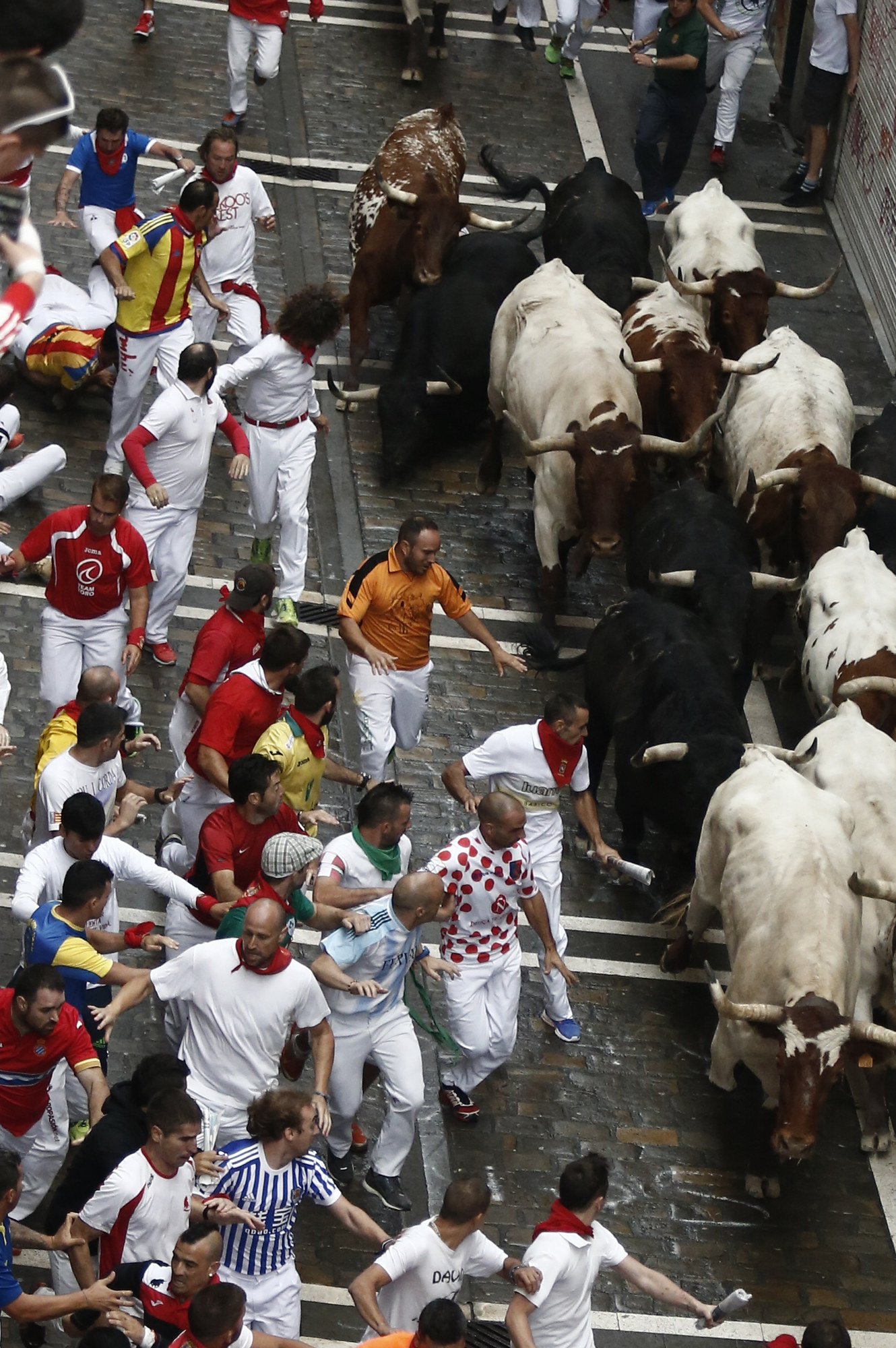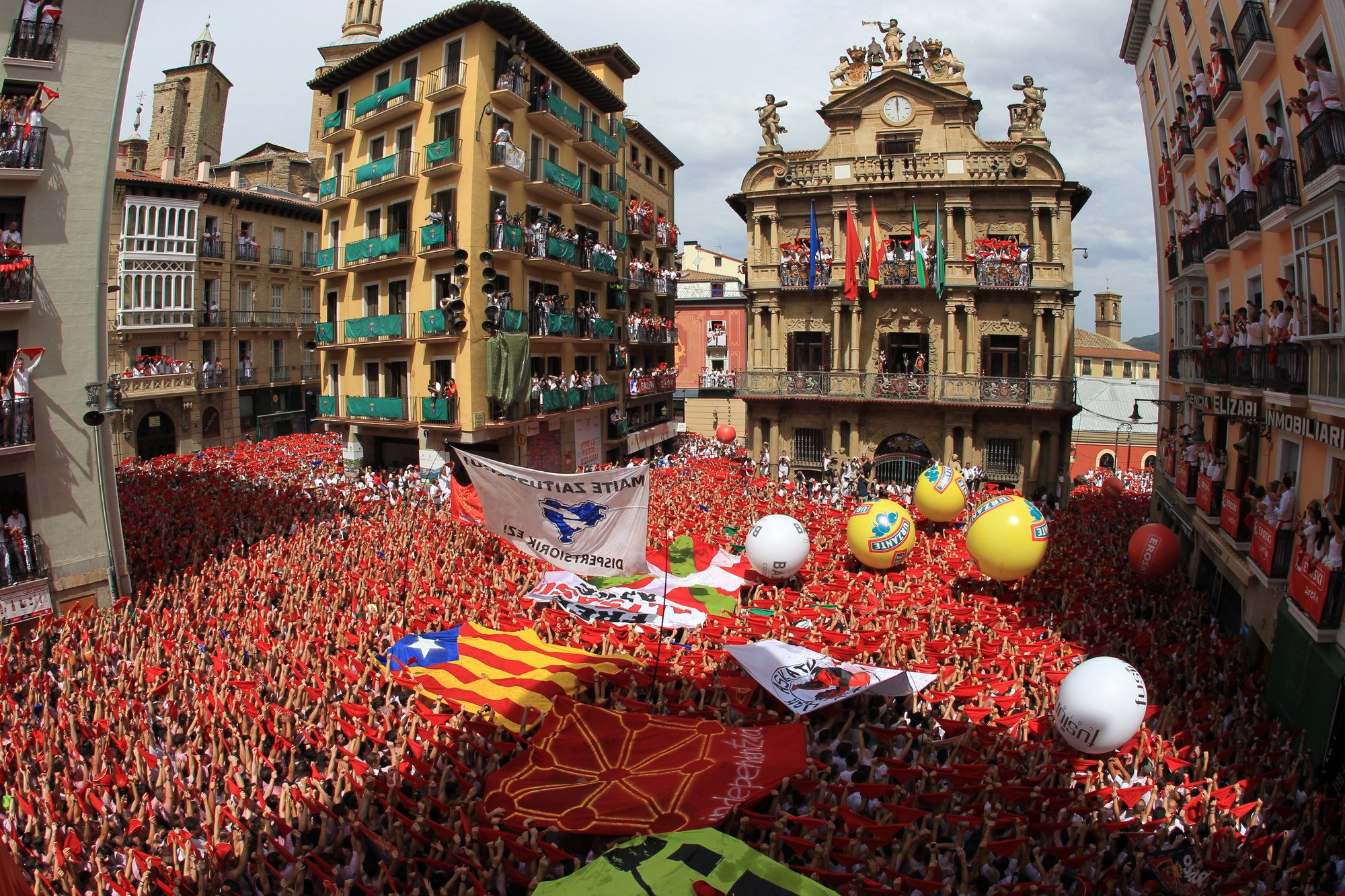by Enrike Díez de Ulzurrun Sagalá
It’s been almost a hundred years since Hemingway first set foot into the city of Pamplona-Iruña to attend the San Fermin festival, festivities that were already famous before the American author arrived, especially because of its livestock fair, which attracted a multitude of brokers and cattle ranchers from the rest of the Basque-speaking territories and surrounding lands.

It wasn’t always this way. Running in front of the bulls and the traditional red and white clothing are customs that were later incorporated into the festival. Photo: Patxi Cascante. Diario de Noticias
At that time, it was a small city, head of the ancient kingdom of Navarre and Basque cultural capital par excellence for centuries, with an eminently rural flavor, a very conservative city, struggling to find spaces for urban development and whose San Fermin festivities were in a way seen as a few days of liberation, providing a break from the rigid social and religious norms that permeated the lives of the population of Pamplona. Pablo Fermin Irigaray, Larreko, a resident of the city, a doctor and writer, already left it written in Basque a few years before the arrival of Hemingway: (translated from Basque) “Screams, noises, sounds, songs on every street during the day, at night… People go crazy like at carnival time, dressed in old clothes and rags for five or six days.” In addition to the atmosphere of fun, dancing and parades of those first decades of the twentieth century, we should add the bullfighting festivities in two formats, the bullfights in the bullring and the characteristic running of the bulls in the streets of the city.
Despite the passage of time, there is still a desire for enjoyment, to have a good time in an extraordinary social environment that fascinates visitors, thousands and thousands of them who crowd the city, or rather, the area of the festival, a space that despite substantial development, growth and modernization of Pamplona in recent decades, is mainly concentrated in the Historic District where the main events take place.

The Chupinazo kicking off the festival became official during the dictatorship in 1940. Paradoxically, the person who began the tradition was executed by the Franco regime. Photo: Javier Bergasa. Diario de Noticias
Still, Sanfermines are not unchanging and are evolving with the pulse of current times. For example, it wasn’t customary to run in front of the bulls until the second half of the 19th century. It was a group of young people probably more drunk than sober who got out in front of the bulls for the first time and they were fined by the mayor’s office for it. The white and red attire (today one of the symbols of the festivities) was not customary until well into the twentieth century. Previously, each association and each group of friends dressed in their own different colors to celebrate the festivity. The association that began to use the white and red colors during the second Republic was harshly repressed after the military uprising of Franco and several of its members were executed. Also executed was Juan Etxepare Aramendia, a likable citizen of Pamplona and member of the Republican Left Party, who used to set off his own rocket at noon on July 6th surrounded by children, back when there was still no official Chupinazo as such, that is, the firework-rocket launched from the main balcony of City Hall that kicks off Sanfermines, an act that was first performed in 1940, and which, today, is one of the most famous scenes of the festivities.
During the second half of the twentieth century, the city was flooded with outsiders who increasingly came to Pamplona from all corners of the world. A worrisome aspect, because of what this massification means, as well as the idea that Sanfermines are to be experienced from the inside and not to be seen from a mere spectator’s perspective, as if it were a pay-to-see event.

Changing times. Nowadays it’s the citizens who choose the protagonists for the Chupinazo. Photo: Iñaki Porto. Diario de Noticias
In addition, there have been positive steps in the integration of women at the festivities for a few years, a necessary step in evolution made evident with generational changes. In spite of everything, some people believe that they have the right to do anything at Sanfermines including the use of women as mere objects. Against this image and such intolerant attitudes, the new governing administrations are working intensely, both the Pamplona City Council and the Government of Navarre. The arrival to the government in 2015 of the new pro-Basque and progressive authorities has brought change that seeks to reach all areas of society. It is a new way of doing politics, open and tolerant, respectful of all the feelings that exist in society, and with a vision that connects with the reality of the 21st century. This is a society which does not tolerate sexist aggressions in any way and one that reacts forcefully and massively against any male-sexist attack. In this regard, the governmental bodies are leading this response against one of the hurdles that persist in all societies nowadays, and unfortunately during festivals as well.
Likewise, with the arrival of the new City Council, the Chupinazo is not launched by the Mayor or a person delegated by the Mayor, but rather is chosen by citizens with a vote for an individual or collective candidate. For this 2018 edition, for example, the Motxila 21 music group, made up of a dozen young people with Down Syndrome, has won the honor. This is another example promoting the integration of all people, in festivals as well, by a society pushing for more open and respectful Sanfermines, who want all sensibilities to have their say, which no longer tolerate attitudes against the dignity of people and who want to preserve the essence of their festival despite the massification. Long live San Femin! Gora San Fermin!

Resounding reaction: the festival at a stand-still to protest against sexist aggressions. Photo: Unai Beroz. Diario de Noticias


Be the first to comment on "Sanfermines and Winds of Change"